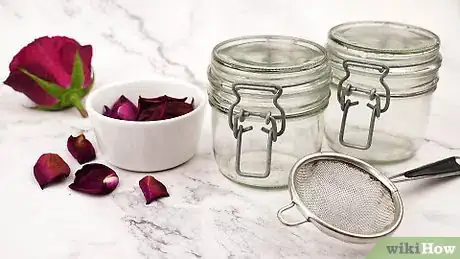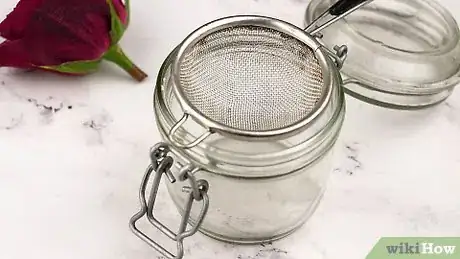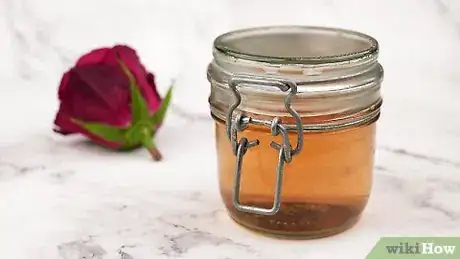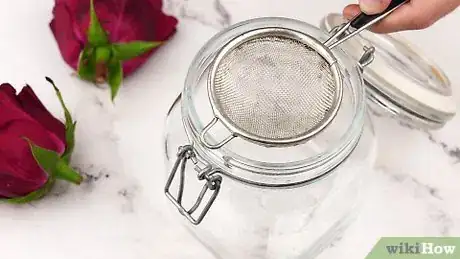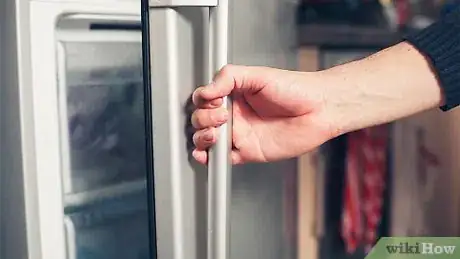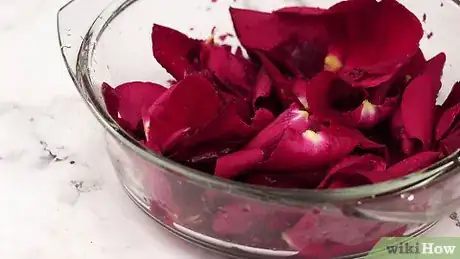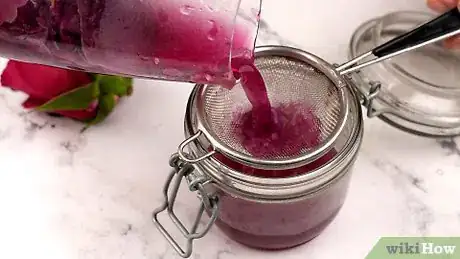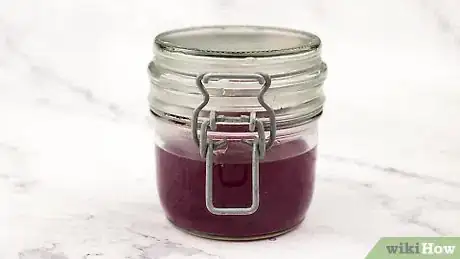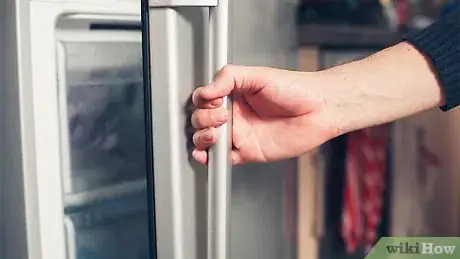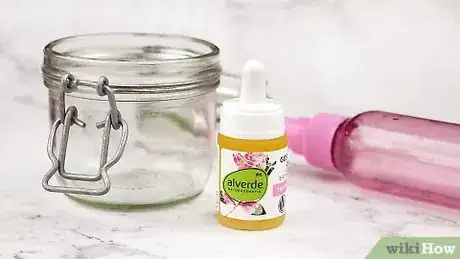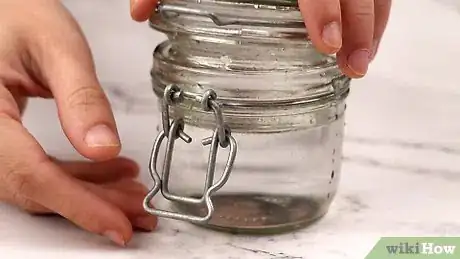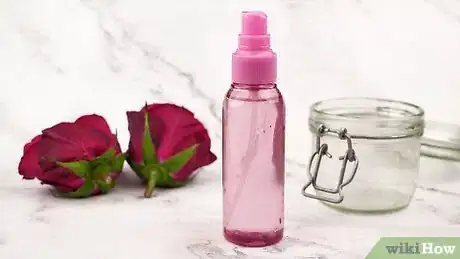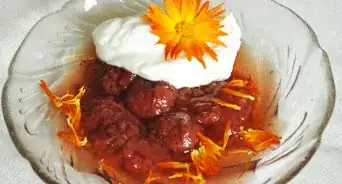This article was co-authored by Joanna Kula. Joanna Kula is a Licensed Esthetician, Owner and Founder of Skin Devotee Facial Studio in Philadelphia. With over 10 years of experience in skincare, Joanna specializes in transformative facial treatments to help clients achieve a lifetime of healthy, beautiful, and radiant skin. She is also a contributing author for the prestigious Les Nouvelles Esthetiques & Spa magazine and has been featured in a number of magazines including InStyle.
There are 12 references cited in this article, which can be found at the bottom of the page.
wikiHow marks an article as reader-approved once it receives enough positive feedback. This article received 30 testimonials and 87% of readers who voted found it helpful, earning it our reader-approved status.
This article has been viewed 964,940 times.
Rosewater can be expensive and difficult to find. However, it is easy to make at home. Rosewater can be used to flavour pastries and cakes, or you can use it in homemade beauty products. You can also use it as a toner and to freshen up your bed sheets.[1] This article will show your four ways to make your own rosewater.
Ingredients
- ¼ cup rose petals, dried
- 1 ¼ cup (300 milliliters) hot, distilled water
- 1 cup rose petals (about 2 roses)
- 2 cups (475 milliliters) distilled water
- 1 teaspoon vodka (optional)
- 16-20 cups (500 grams) rose petals
- Distilled water (as needed)
- 12 drops of rose essential oil
- 1 cup (240 milliliters) distilled water
Steps
Making Rosewater with Dried Petals
-
1Gather your supplies. In addition to the dried rose petals and hot water, you will also need two glass mason jars and a strainer.
-
2Put the dried rose petals into one of the jars. If you want to use this water for cooking, then consider getting dried petals from edible roses, such as Rosa damascena, Rosa Centifolia and Rosa Gallica.[6] They will give you the best taste.Advertisement
-
3Pour hot, but not boiling, water over the petals. Make sure that you are using distilled water, which is free of any bacteria. If you cannot find distilled water, then you can use filtered water instead.
-
4Cover the jar and let the water cool. This will take about 10 to 15 minutes, depending on the temperature of the room.
-
5Put a strainer over the empty jar. You will be transferring the rosewater into this jar; the strainer will catch the rose petals.
-
6Pour the rosewater into the jar. Carefully put the water in the strainer, so that the water flows into the empty jar and the petals get caught in the strainer. Once all of the water is in the new jar, you can discard the petals.
-
7Seal the jar and store it in the fridge. You will need to use this rosewater within one week if you leave it at room temperature, or else it will expire. Put the container in the fridge and store it for up to 3 months.[7]
Making Rosewater with Fresh Petals
-
1Select some fresh, fragrant roses and rinse them. The fresher your roses are, the better results you will get.[8] Try to use organic, pesticide-free roses; even though you will be washing them later on, there is no guarantee that you will be able to completely rinse all of the chemicals off. Also, try to use just one type of rose; each type has its distinctive smell, and you may not get good-smelling results by mixing them. Be sure to rinse the rose well to get rid of any dirt, insects, and pesticides.
- If you wish to use the rosewater for cooking, consider using some edible roses types, such as: Rosa damascena, Rosa Centifolia and Rosa Gallica.[9]
-
2Pull the petals off and discard the rest of the rose. You will need enough petals to fill one cup. This should take about two roses, depending on the size of the rose.
-
3Place the petals into a saucepan and pour water over them. Make sure that the petals are evenly distributed, and that the water level does not come too far past the petals. If you use too much water, your rosewater will be less fragrant.[10]
- Consider adding up to one teaspoon of vodka. This will not affect the smell, but it will help preserve the rosewater and make it last longer.[11]
-
4Cover the pot with a lid and set the heat to "low." Do not let the water come to a boil or a simmer; using too much heat will ruin the color and other properties. After about 20 minutes, you will see the petals become paler, and the water take on the color of the petals.
-
5Place a strainer over a large mason jar. Make sure that the jar is very clean, and that it is big enough to hold about 2 cups (475 milliliters) of water. You will be using the strainer to catch the petals.
-
6Pour the rosewater into the jar. Using both hands, hold the pot over the jar and tip it carefully. Slowly pour the water and petals through the strainer and into the jar. The water will pass through the strainer, and the petals will get caught in it.
- Consider filling a smaller bottle with some of the rosewater. A smaller bottle will be easier to handle than a large mason jar. When you run out of rosewater, simply refill it with more rosewater from the big jar.
-
7Store in the refrigerator. The rosewater will keep for only a week at room temperature, but it lasts about 2–3 months in the fridge.[12] If you added vodka, it should last a bit longer.
Making Rosewater with Crushed Petals
-
1Divide the rose petals into two piles. You will crush one pile first, and use the other one later.
-
2Grind the first pile using a mortar and pestle. As you crush the petals, they will release juice; you will be using this juice to make your rosewater. You can also rub the petals against a strainer; simply place the strainer over a jar, and scrub the petals across the mesh using the back of a spoon.
-
3Put the rose water and crushed petals into a ceramic bowl. You can also use a glass jar or bowl. Leave the rose water and petals in the bowl for a few hours; this allows the liquid to become even more saturated.
-
4Add the rest of the petals and let them sit for 24 hours. Stir the fresh petals through the crushed ones. Cover the bowl and let it sit undisturbed for 24 hours.
-
5Transfer the rose water and petals to a glass or ceramic saucepan. Don't use metal pot; this will react with the oils.
-
6Simmer the rose water and petals over low heat. Place the saucepan on the stove and set the heat to low. Bring the rose petals to a simmer. Once you start to see bubbles, remove the pot from the burner.
-
7Pour the rosewater into a jar through a strainer. You can also use a coffee filter or a muslin cloth. Keep doing this until there are no more specks of petal in the rosewater.
- If you wish to use the rosewater as a toner, then dilute it with some distilled water until you get the strength you like.
-
8Seal the jar and leave in a sunny spot for a few hours. The heat of the sun will help draw out the natural, beneficial oils.
-
9Store the rose water in the refrigerator. Use the water within one week if you leave it at room temperature, or it will expire. Otherwise, you can store it in the fridge for up to 3 months.[13]
Making Rosewater with Essential Oil
-
1Gather your supplies. In addition to the rose essential oil and distilled water, you will also need a glass jar; if you are going to use this as a misting spray, then you will also need a misting bottle. Make sure that the bottle is made from glass or high-quality plastic. Avoid metal or low-quality plastic.
-
2Fill the jar with water. Be sure to use distilled water instead of tap water; tap water often has bacteria in it. If you cannot find distilled water anywhere, then boil some filtered water and let it cool back down to room temperature.
-
3Add 12 drops of rose essential oil. You will have to dilute this in a couple of teaspoons of vodka first or it will just float on top of the water. Make sure that you are using pure essential oil, and not fragrance oil. Fragrance oil will only give you the smell, and none of the benefits found in roses and pure essential oils.
-
4Close the jar tightly and shake it. Do this for a few moment to mix the oil into the water.
-
5Consider transferring the rosewater to another container. You can leave the rosewater in the jar, or you can pour it through a funnel into a misting bottle and use it to freshen your linens or your face.
Expert Q&A
-
QuestionHow long can rose water be stored?
 Lorena BarcalLorena Barcal is a Clinical Herbalist, Clean Beauty Specialist, and Writer for IslandBeauty.co, a blog dedicated to sharing the benefits of using all-natural beauty products and recipes created by herbalists. Lorena specializes in studying and developing natural alternatives for beauty products. After finishing her herbal studies, Lorena managed an herbal lab in Barcelona developing natural beauty products. As a writer for IslandBeauty.co, she shares knowledge and insights to promote the natural beauty industry.
Lorena BarcalLorena Barcal is a Clinical Herbalist, Clean Beauty Specialist, and Writer for IslandBeauty.co, a blog dedicated to sharing the benefits of using all-natural beauty products and recipes created by herbalists. Lorena specializes in studying and developing natural alternatives for beauty products. After finishing her herbal studies, Lorena managed an herbal lab in Barcelona developing natural beauty products. As a writer for IslandBeauty.co, she shares knowledge and insights to promote the natural beauty industry.
Clinical Herbalist & Clean Beauty Specialist Store rose water at room temperature for 1 week or for 2-3 months in the refrigerator.
Store rose water at room temperature for 1 week or for 2-3 months in the refrigerator. -
QuestionIs it okay to use the rosewater with the vodka in it on my face?
 Community AnswerYes, vodka mixed with equal parts water is used as an astringent to cleanse the face and tighten pores.
Community AnswerYes, vodka mixed with equal parts water is used as an astringent to cleanse the face and tighten pores. -
QuestionIf I use more rose petals, will the rosewater last longer?
 Community AnswerNo, it will just be more concentrated. Just make a small batch each time so you don't run the risk of it going bad.
Community AnswerNo, it will just be more concentrated. Just make a small batch each time so you don't run the risk of it going bad.
Warnings
- Do not use tap water. Tap water often contains bacteria. Use only distilled water or boiled, filtered water.[16]⧼thumbs_response⧽
- Never store your rosewater in metal or low-quality plastic containers. Metal bottles can react with the natural oils in rosewater. The chemicals from low-quality plastic bottles can seep into the rosewater, lowering the quality.[17]⧼thumbs_response⧽
Things You'll Need
Things You'll Need for Essential Oil Based Rosewater[18]
- Glass jar
- Misting bottle
Things You'll Need for Dried Petal Rosewater
- 2 heat-proof glass jars
- Strainer
Things You'll Need for Fresh Petal Rosewater[19]
- Strainer
- 16 ounce (475 milliliter) sterilized glass jar
- Small bottle (optional)
Things You'll Need for Crushed Petal Rosewater
- Pestle and mortar
- Ceramic bowl
- Ceramic or glass saucepan
- Strainer, muslin cloth, or coffee filter
- Glass jar
References
- ↑ Joanna Kula. Licensed Esthetician. Expert Interview. 9 July 2019.
- ↑ A Delightful Home, How to Make Rosewater
- ↑ She Knows, DIY Rosewater Toner
- ↑ Reader's Digest, Back to Basics, p. 342, (2003), ISBN 0-86449-028-3
- ↑ One Good Thing by Jillee, DIY Coconut Oil Body Wash
- ↑ The Beauty Gypsy, How to Make Rosewater
- ↑ Lorena Barcal. Clinical Herbalist & Clean Beauty Specialist. Expert Interview. 28 June 2020.
- ↑ Free People, DIY: How to Make Rosewater
- ↑ The Beauty Gypsy, How to Make Rosewater
- ↑ She Knows, DIY Rosewater Toner
- ↑ Soap Deli News, Homemade Rosewater Recipe
- ↑ Lorena Barcal. Clinical Herbalist & Clean Beauty Specialist. Expert Interview. 28 June 2020.
- ↑ Lorena Barcal. Clinical Herbalist & Clean Beauty Specialist. Expert Interview. 28 June 2020.
- ↑ Joanna Kula. Licensed Esthetician. Expert Interview. 9 July 2019.
- ↑ One Good Thing by Jillee, Make Your Own Rose Water Spray
- ↑ Crunchy Betty, DIY 101 – Working with Water
- ↑ Whole New Mom, Homemade Rosewater Spray Recipe
- ↑ One Good Thing by Jillee, DIY Coconut Oil Body Wash
- ↑ She Knows, DIY Rosewater Toner
About This Article
To make rosewater, start by rinsing some roses under cool water and then removing all of their petals. Then, put the petals in a pot and cover them with water. Once the petals are covered with water, put a lid on the pot and heat it over low heat for 20 minutes. Finally, strain the petals over a mason jar to collect all of the rosewater. Cover the jar and store your rosewater in the fridge for up to a week. If you want to learn how to use dried petals or rose essential oil, keep reading the article!

